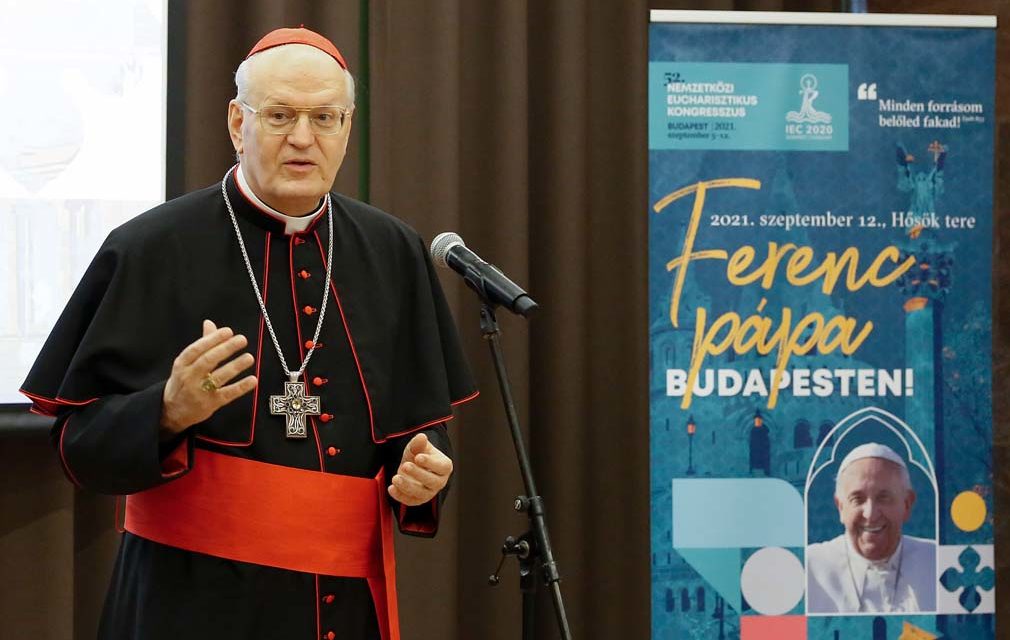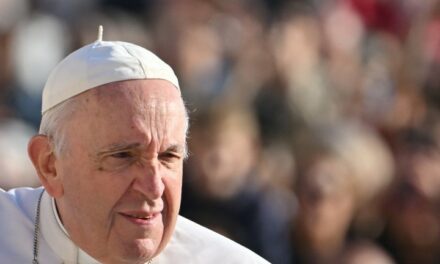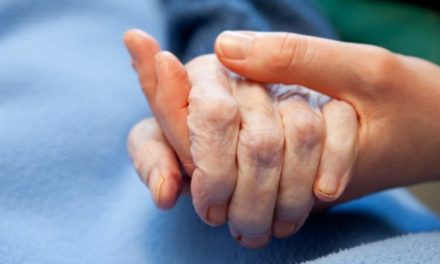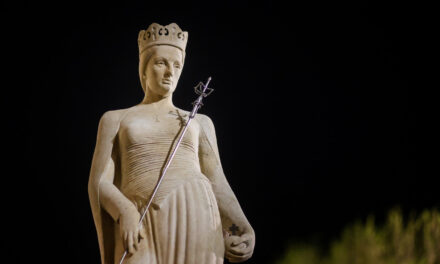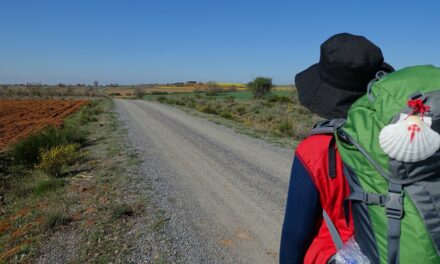Below you can read Cardinal Péter Erdő's writing, Primate, regarding the beginning of the 52nd International Eucharistic Congress (INEC), which Új Ember on September 5-12, 2021.
When Pope Francis selected Budapest as the venue for the next International Eucharistic Congress in 2016, we were very happy, but also scared. Not only because we sensed the great organizational work ahead of us, but mostly because we thought about how far the concept of the Eucharist and the congress is from today's public thinking. Where are we today in terms of human education, especially in the field of religious culture, compared to what was almost natural in our country at the time of the previous World Congress! We have only just explained the meaning of the congress.
"This word means not just a scientific conference, but a gathering, a joint celebration in its original sense."
Of course, there was scientific preparation here. We held scientific conferences three times in Esztergom with pastoral and theological content and an ecumenical outlook. We also prepared a theological document, which was approved by the Holy See. Its title was the motto of our congress: "All my resources come from you." Its subtitle read: The Eucharist is the source of Christian life and the mission of the Church. This substantial document has been published in many languages.
However, the second and most important word, Eucharist, needs to be explained again and again. In Hungarian, at least three terms are needed to convey the richness of its meaning: Holy Mass, Holy Communion, Holiness of the Altar . But if we think about the word Eucharist, it leads us to the last supper and the person of Jesus. In the Gospels, the words of the foundation of the Blessed Sacrament are introduced by the remark that Jesus gave thanks, broke the bread, and gave it to his disciples (Luke 22:19). This is the thanksgiving from which the Eucharist takes its name. But the Latin liturgy also preserves the original name of the action performed by Jesus, when it says: "giving thanks, he said a blessing." In the Gospel of Matthew, we find directly that Jesus "said the blessing, then broke the bread, gave it to his disciples and said: take and eat, this is my body" (Mt 26,26).
"We are there in the hall of the last supper, where Jesus says the blessing according to the ancient custom of the Passover supper, and we are also there on Golgotha, where he gives his body and blood for us. Forward. Mysteriously. Still. At every Mass. Because his presence stretches the boundaries of space and time. It sheds light on the mystery of God's way in the world. It reveals man's secret and vocation."
But how can we display this in the Hungexpo area or on Andrássy út, and how can we experience it in our churches every day? This had to be answered during the years of pastoral preparation. That's why we chose the missionary cross as a visual symbol of the congress. The cross that the successful artist Csaba Ozsvári made for the city mission in 2007. In this cross, we included the relics of Hungarian saints and blessed ones, from the time of St. István and St. Gellert to the present day. We also added the remains of the most recent martyrs, Hungarians and non-Hungarians from the entire Carpathian basin and nearby regions. Because the saints show us how we can carry the presence of Christ in a thousand different situations in our lives today, with inventive and sacrificial love. This cross visited the cities of our country and neighboring countries. It was a call to prayer, repentance, and learning the example of the saints. It has traveled more than seventy thousand kilometers in recent years. It started from the Apostolic Palace in the Vatican, where it was blessed by Pope Francis. He will end his missionary journey in Heroes' Square, at the Holy Mass, which will also be led by the Holy Father.
But it is not only the saints raised on the altar who proclaim the effect of encountering Christ in our lives. There were also messengers of the Eucharistic Congress who are alive today. And these messengers are well-known scientists, artists, great and famous individuals who personally went to the Catholic communities to bear witness to their faith and life and to invite everyone to the great meeting in Budapest. Respect and gratitude are due to them for their personal standing and for the fact that they agreed to belong to Christ before the world.
"It is no coincidence that testimonies play an important role in the program of the congress itself. Men and women, priests and lay people from different parts of the world talk about their faith, their journey and the special charisma they have received for the benefit of the Church."
And what should we do? We can draw inspiration from the lives of saints and witnesses, but we also have concrete opportunities for action. That is why we held a joint meal with hundreds of needy people the day before the opening mass of the congress at the II. Pope János Pál square and in many cities of our country. The charity service of our Church will be presented starting in August in the exhibition in Vigado, which deals with the activities of Catholic Charities. Thousands of volunteers take part in the work of the congress. With their discreet service, they also help the needy, those asking for guidance, the physically challenged, and all those who need a clear word and a friendly hand.
"The vocation of the International Eucharistic Congress is to take Christ to the world. "All my resources come from you." This is our motto. And the water of the spring does not stop at the threshold of the church, but wants to give life to the whole world around it."
The quote is the last line of Psalm 87. And before that we find a huge vision. A vision of the heavenly Jerusalem, where the Egyptians and the Babylonians, the Tyrians and the Ethiopians, and all the peoples who once fought against each other will be together. And the Almighty writes in the book of life that "these were all born here". Such feelings arose in us when we decided to keep the hymn of the 1938 World Eucharistic Congress. After all, it has become a public treasure, and after many decades it still lives deep in the souls of our people. It was touching to hear in Csíksomlyo in 2019, at the papal mass, that this hymn was sung by the entire crowd of hundreds of thousands, and even without a single verse, from the beginning to the end. After more than eighty years. Then how about we sing the same thing, with an original melody and a youthful, renewed melody, because it's still timely today! It is Christ who does not want to eliminate peoples, but to fuse them together in peace in an atmosphere of reconciliation, respect and love. That is why it is such a great pleasure for us that the interest in the congress is alive among Hungarians and neighboring peoples as well.
A special event on Thursday morning will be the mass in the Lovár language, with artistically arranged gypsy melodies. For the first time in history, the text of the Holy Mass is sung in this language and with the spirit of this culture. Let this event symbolize the meeting of peoples and their determined will to live together in love.
If we meet around Christ, we also look at our own place differently. On the afternoon of September 11, in front of the Parliament, we can hear the words of the Orthodox Patriarch of Constantinople Bartholomaios for the first time. He was the one who consecrated our first king as a saint for the Orthodox Church in Budapest in 2000, in front of St. Stephen's Basilica. Our country is the meeting place of East and West. We warmly welcome Eastern Catholic and Orthodox patriarchs and bishops among our guests, who share with us the faith and respect for the Blessed Sacrament. After that, the Holy Mass will follow in Kossuth Square, where the Holy Crown and the Holy Right will be shown on the projector, as a symbol of the fact that Christianity and Hungarianness have walked the path of history together for a thousand years. This will be followed by a torchlit procession in honor of the Blessed Sacrament along Andrássy út, all the way to Hősök Square. May the path of the Blessed Sacrament bring blessings to our city, our country, Europe and the whole world!
The crowning of the festive program will be the papal mass on the Heroes Square on September 12. This final event is called Statio Orbis. In ancient times, only one mass was held in the big cities during special holy times under the leadership of the city's bishop. The clergy and the large religious community gathered there, because then the whole city almost visibly met around the table of Christ. At the Statio Orbis Mass, the entire Catholic world symbolically meets around the altar. This celebration is especially great if the ceremony is led by the Pope himself, the successor of Peter, whose mission is to strengthen his brothers. With this spirit, let us participate in Pope Francis' Holy Mass, which is also ours, all of us, the act of Christ himself and the entire Church.
Let's meet Jesus in Budapest!
Photo: Photo: IEC 2020

